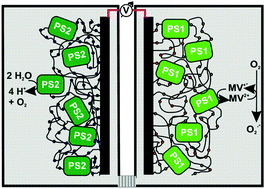Redox hydrogels with adjusted redox potential for improved efficiency in Z-scheme inspired biophotovoltaic cells†
Abstract
The improvement of Z-scheme inspired biophotovoltaics is achieved by fine tuning the properties of redox hydrogels applied as immobilization and electron conducting matrices for the photosystem–protein complexes. The formal potentials of the redox hydrogels are adjusted to the respective redox sites in the photosystems for optimized electron transfer without substantial voltage loss. The anode is based on photosystem 2 (PS2) integrated in a phenothiazine modified redox hydrogel with a formal potential of −1 mV vs. SHE, which is 59 mV more positive than the QB acceptor site in PS2. The cathode is based on photosystem 1 (PS1) contacted via an Os-complex based redox hydrogel with a formal potential of 395 mV vs. SHE, i.e. 28 mV more negative than the primary P700 electron acceptor of PS1. The potential difference between the two redox hydrogels is 396 mV. An open circuit voltage (VOC) of 372.5 ± 2.1 mV could be achieved for the biophotovoltaic cell. The maximum power output is 1.91 ± 0.56 μW cm−2 and the conversion efficiency (η) is 4.5 × 10−5, representing a 125-fold improvement in comparison to the previously proposed device exploiting the photosynthetic Z-scheme for electrical energy production.

- This article is part of the themed collection: Photosynthesis: From Natural to Artificial

 Please wait while we load your content...
Please wait while we load your content...